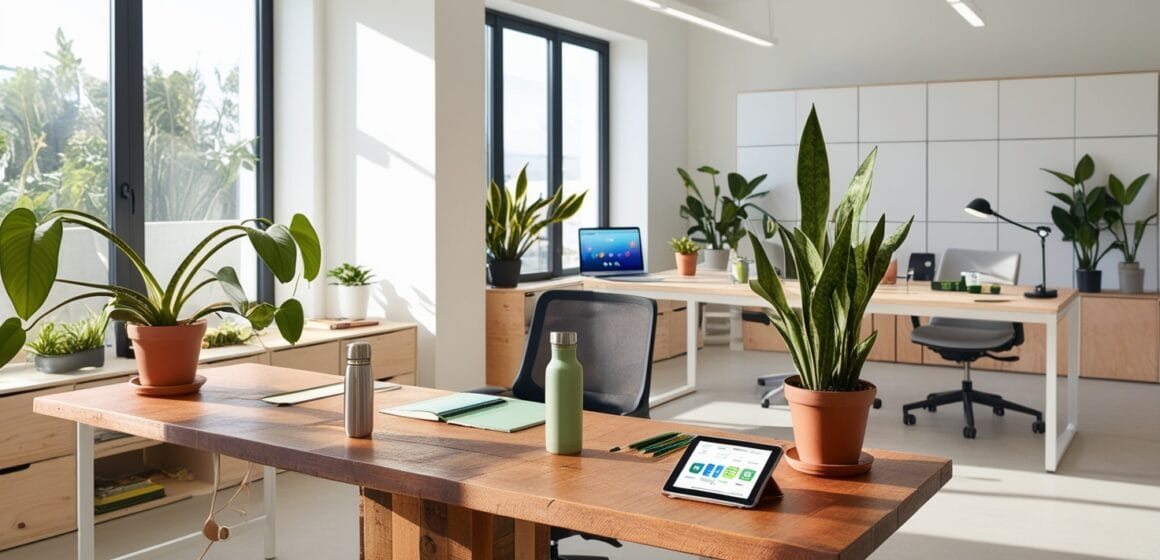The shift to remote work has transformed how we think about our workspaces, and with sustainability on everyone’s mind, creating an eco-friendly home office is a step toward reducing our environmental footprint. An eco-conscious workspace not only benefits the planet but also promotes well-being and productivity. Here’s how to set up a sustainable home office that aligns with your values and enhances your workflow.
1. Choose Sustainable Furniture
The foundation of an eco-friendly workspace begins with sustainable furniture.
- Reclaimed or Recycled Materials: Opt for desks, chairs, and shelves made from reclaimed wood, recycled metals, or other sustainable materials. These options often have a lower environmental impact compared to new, mass-produced furniture.
- Ergonomic and Durable: Invest in high-quality, durable furniture to reduce waste over time. Ergonomic designs ensure comfort, which is vital for long hours at your desk.
- Second-Hand Options: Consider purchasing pre-owned furniture from thrift stores or online marketplaces to give items a second life.
2. Maximize Natural Light
Lighting plays a significant role in both energy efficiency and productivity.
- Utilize Natural Light: Position your desk near windows to make the most of daylight, reducing the need for artificial lighting.
- Energy-Efficient Bulbs: When artificial lighting is necessary, choose LED or CFL bulbs, which consume less energy and last longer than traditional incandescent bulbs.
- Smart Lighting Systems: Use smart plugs or timers to ensure lights are turned off when not needed.
3. Reduce Energy Consumption
Energy-efficient practices can significantly cut down your carbon footprint.
- Energy Star Electronics: Choose computers, monitors, and printers with Energy Star certification to ensure energy efficiency.
- Power Strips: Use advanced power strips to prevent energy waste from devices in standby mode.
- Unplug Devices: When not in use, unplug chargers and electronic equipment to minimize phantom energy usage.
4. Go Paperless
A digital-first approach can save resources and declutter your workspace.
- Cloud Storage: Use cloud-based tools like Google Drive, Dropbox, or Microsoft OneDrive to store documents electronically.
- Digital Note-Taking: Replace paper notebooks with apps like Evernote or Notion to organize your ideas.
- Eco-Friendly Printing: If printing is unavoidable, use recycled paper and eco-friendly ink cartridges.
5. Incorporate Greenery
Adding plants to your home office is an excellent way to improve air quality and create a calming atmosphere.
- Air-Purifying Plants: Choose low-maintenance, air-purifying plants like snake plants, pothos, or peace lilies.
- Sustainable Pots: Use biodegradable or recycled pots for your plants.
- Local Nurseries: Buy plants from local growers to reduce transportation emissions.
6. Use Sustainable Office Supplies
Everyday office essentials can also be eco-friendly.
- Recycled Products: Opt for notebooks, pens, and organizers made from recycled materials.
- Reusable Options: Use refillable pens, rechargeable batteries, and reusable water bottles.
- Minimal Packaging: Choose suppliers that prioritize minimal or plastic-free packaging.
7. Optimize Your Workspace for Efficiency
An efficient workspace minimizes waste and maximizes productivity.
- Declutter: Keep your desk organized to reduce distractions and improve focus.
- Modular Design: Use modular furniture that can be adapted or repurposed as your needs change.
- Proper Ventilation: Ensure your workspace is well-ventilated to maintain air quality without overusing air conditioning or heating.
8. Dispose of E-Waste Responsibly
As technology evolves, old electronics pile up. Proper disposal is essential.
- Recycle Electronics: Use certified e-waste recycling programs to dispose of old computers, monitors, or phones.
- Donate Usable Tech: If your old devices still work, donate them to schools or organizations in need.
The Benefits of an Eco-Friendly Home Office
Creating a sustainable workspace has far-reaching advantages:
- Environmental Impact: Reduced energy consumption and waste contribute to a healthier planet.
- Cost Savings: Energy-efficient practices and durable products save money over time.
- Personal Well-Being: A thoughtfully designed workspace with natural light and plants promotes mental clarity and reduces stress.
Conclusion
Setting up an eco-friendly home office doesn’t require a complete overhaul. Small, intentional changes can make a big difference for both the environment and your work life. By choosing sustainable furniture, reducing energy consumption, and embracing digital tools, you can create a workspace that’s as kind to the planet as it is productive for you.




Leave a Reply